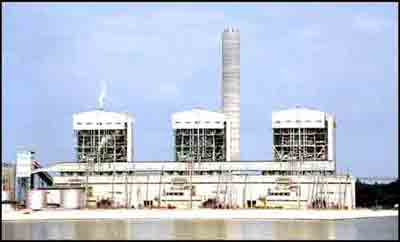Manjung Power Plant
 The Manjung coal-fired power plant in Malaysia is now producing up to 2,100MW from its three 700MW units. The plant is sited on a man-made island off the coast of Perek, making coal imports easier. The 700MW units were seen as more economical than four 500MW units, and were commissioned between September 2002 and September 2003. The project suffered some delay as a result of the 1997/8 Asian economic crisis.
The Manjung coal-fired power plant in Malaysia is now producing up to 2,100MW from its three 700MW units. The plant is sited on a man-made island off the coast of Perek, making coal imports easier. The 700MW units were seen as more economical than four 500MW units, and were commissioned between September 2002 and September 2003. The project suffered some delay as a result of the 1997/8 Asian economic crisis.
The new plant is helping Malaysia to keep pace with its rapidly rising electricity demand. Demand is expected to reach 13,000MW by the end of 2005. If the 30% reserve margin is to be acheived, capacity needs to reach 16,505MW by the end of 2005. To meet this, a major programme of coal and gas power plant building is necessary.
Any delays in this building will lead to shortages and hence adverse effects on the total economy.
The government has allowed moderate investment in new capacity as a side effect of the economic turmoil, and has also urged electricity efficiency drives. The rate of electricity demand has approximately halved, but this did not affect the Manjung plant, as other projects were have been postponed in preference to it.
The island on which the site is located is off the coast of Lekir. The land was reclaimed between September 1997 and May 1999, which meant that ABB could start construction in July 1999.
A consortium formed by ABB Alstom Power Plants Ltd and Peremba Construction Sdn Bhd was selected as the engineering, procurement and construction (EPC) contractor for the project. ABB Alstom owns 75%, and the Malaysian Peremba owns the rest. Lekir Bulk Terminal Sdn Bhd (LBT) built a terminal to offload the six million tonnes of coal the plant should use each year. The jetty serves vessels of as much as 150,000t. The plant was built on 254ha of the 320ha of reclaimed land on the island. Of the 254ha, 70ha was for the power plant and 175ha for the ash pond. The rest was used for the terminal facilities. Leighton Asia designed and constructed the jetty, which was completed in September 2002. The estimated cost was RM310 million (€93 million).



